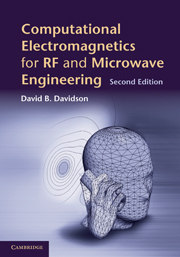Book contents
- Frontmatter
- Dedication
- Contents
- Preface to the second edition
- Preface to the first edition
- Acknowledgements
- To the reader
- List of notation
- 1 An overview of computational electromagnetics for RF and microwave applications
- 2 The finite difference time domain method: a one-dimensional introduction
- 3 The finite difference time domain method in two and three dimensions
- 4 A one-dimensional introduction to the method of moments: modelling thin wires and infinite cylinders
- 5 The application of the FEKO and NEC-2 codes to thin-wire antenna modelling
- 6 The method of moments for surface modelling
- 7 The method of moments and stratified media: theory
- 8 The method of moments and stratified media: practical applications of a commercial code
- 9 A one-dimensional introduction to the finite element method
- 10 The finite element method in two dimensions: scalar and vector elements
- 11 The finite element method in three dimensions
- 12 A selection of more advanced topics in full-wave computational electromagnetics
- Appendix A The Whitney element
- Appendix B The Newmark-β time-stepping algorithm References
- Appendix C On the convergence of the MoM Reference
- Appendix D Useful formulas for simplex coordinates
- Appendix E Web resources
- Appendix F MATLAB files supporting this text
- Index
- References
11 - The finite element method in three dimensions
Published online by Cambridge University Press: 05 July 2014
- Frontmatter
- Dedication
- Contents
- Preface to the second edition
- Preface to the first edition
- Acknowledgements
- To the reader
- List of notation
- 1 An overview of computational electromagnetics for RF and microwave applications
- 2 The finite difference time domain method: a one-dimensional introduction
- 3 The finite difference time domain method in two and three dimensions
- 4 A one-dimensional introduction to the method of moments: modelling thin wires and infinite cylinders
- 5 The application of the FEKO and NEC-2 codes to thin-wire antenna modelling
- 6 The method of moments for surface modelling
- 7 The method of moments and stratified media: theory
- 8 The method of moments and stratified media: practical applications of a commercial code
- 9 A one-dimensional introduction to the finite element method
- 10 The finite element method in two dimensions: scalar and vector elements
- 11 The finite element method in three dimensions
- 12 A selection of more advanced topics in full-wave computational electromagnetics
- Appendix A The Whitney element
- Appendix B The Newmark-β time-stepping algorithm References
- Appendix C On the convergence of the MoM Reference
- Appendix D Useful formulas for simplex coordinates
- Appendix E Web resources
- Appendix F MATLAB files supporting this text
- Index
- References
Summary
In this penultimate chapter, the preceding discussion of the finite element method is extended to three dimensions. We start by extending the eigenanalysis of the preceding chapter to three dimensions, using Whitney elements. Although a 3D FEM code is non-trivial to implement, simple problems can nonetheless be addressed, and the eigenanalysis of a PEC cavity is used to illustrate the development of a 3D FEM code. Higher-order vector elements have already been introduced in the preceding chapter for two-dimensional analysis; in this chapter, a more detailed theoretical treatment will be presented for the more general three-dimensional case, and an LT/QN element is applied to the cavity eigenanalysis problem. Following this, the stationary functional formulation for deterministic (driven) problems will be outlined. In this and the preceding chapter, eigenvalue problems have been used to illustrate the FEM; in this chapter, a deterministic three-dimensional problem will also be discussed, namely the analysis of waveguide obstacles. Finite element analysis is ideal for this problem, and good results have been obtained by a number of workers. Results for two waveguide problems computed using FEM codes incorporating higher-order elements will be shown. The chapter concludes with a discussion on the use of absorbing boundary conditions for open-region problems, and a first-order ABC is presented. Treatment of a more sophisticated scheme is deferred to the final chapter.
Information
- Type
- Chapter
- Information
- Computational Electromagnetics for RF and Microwave Engineering , pp. 407 - 450Publisher: Cambridge University PressPrint publication year: 2010
